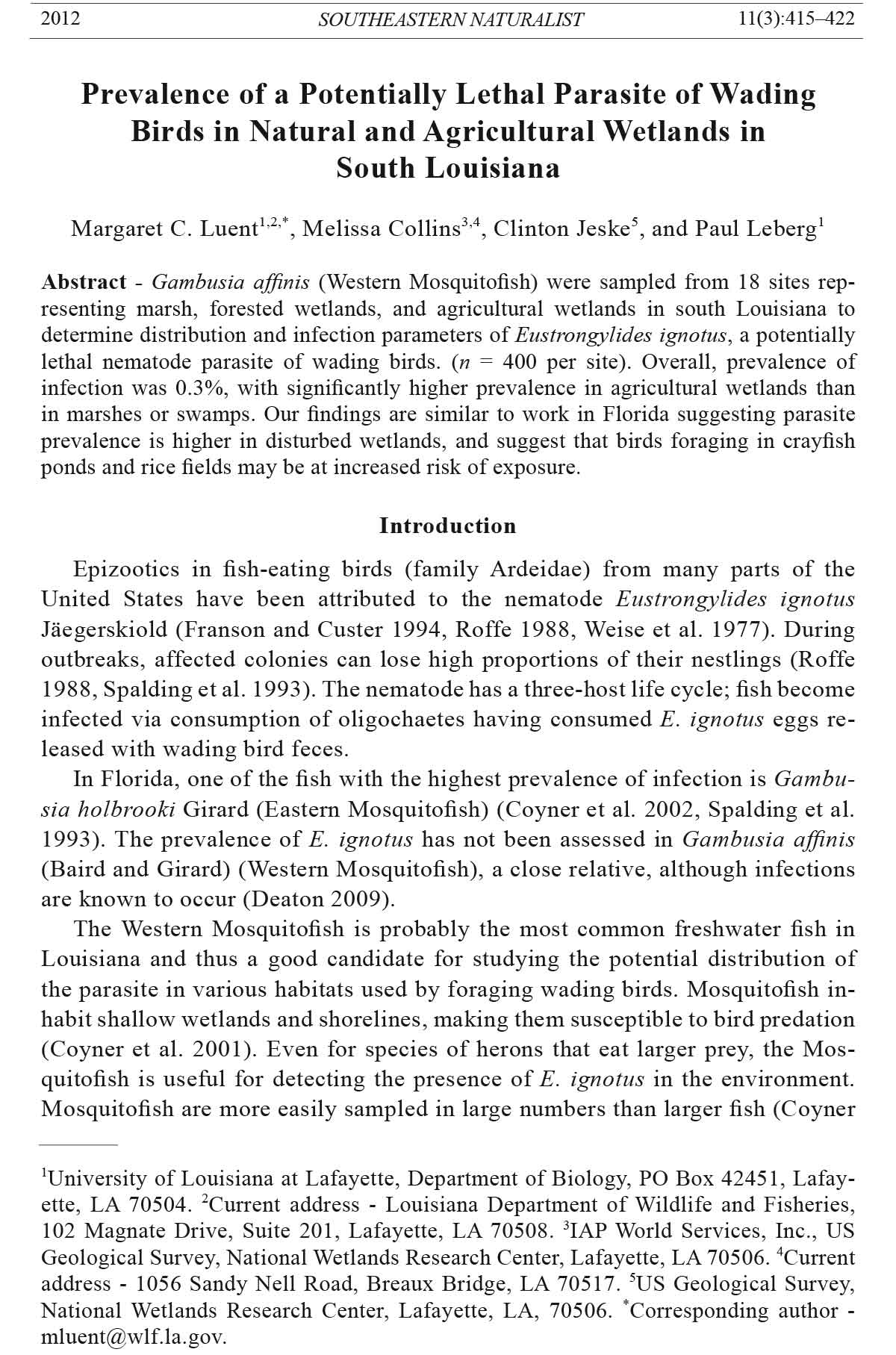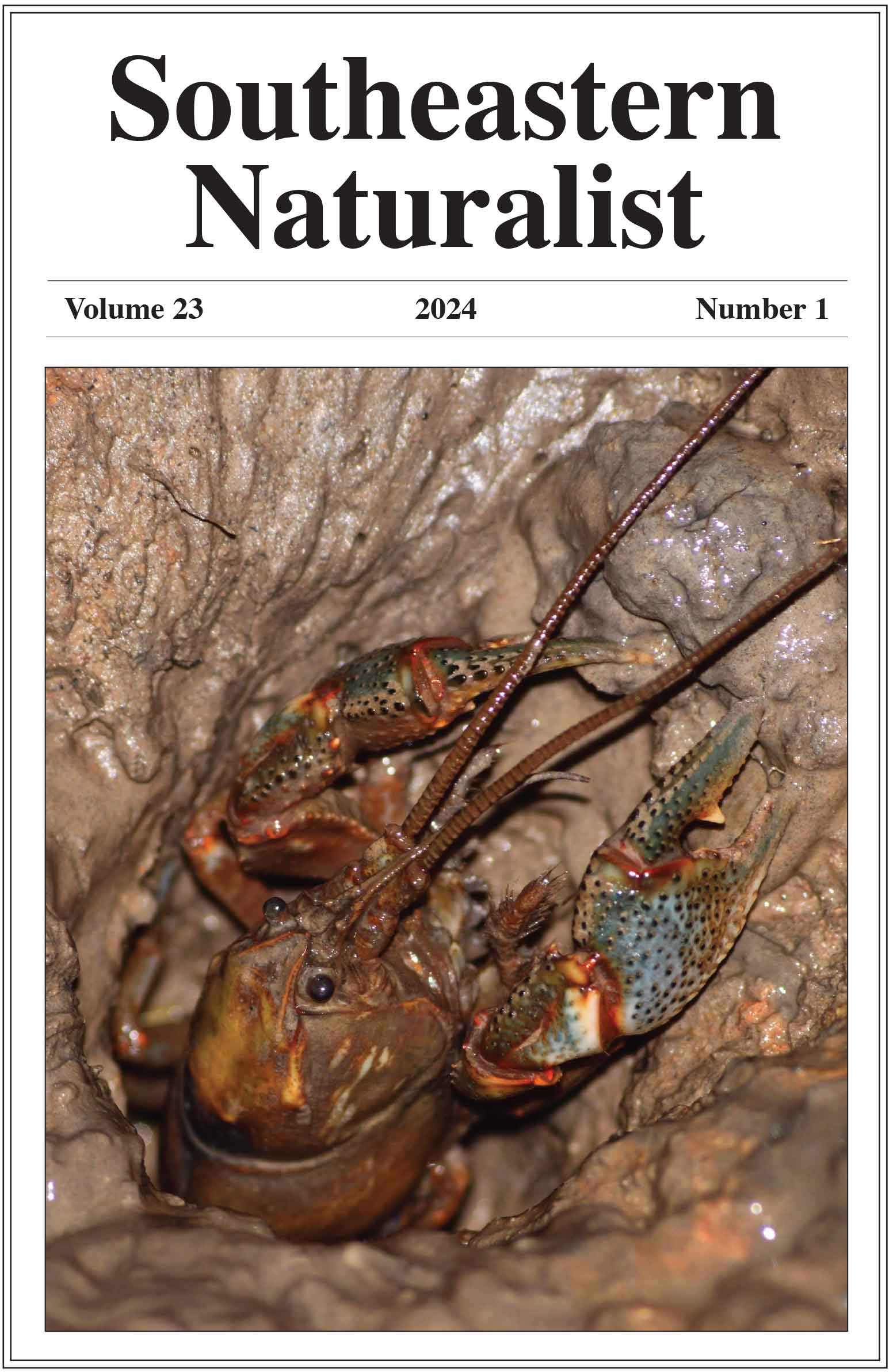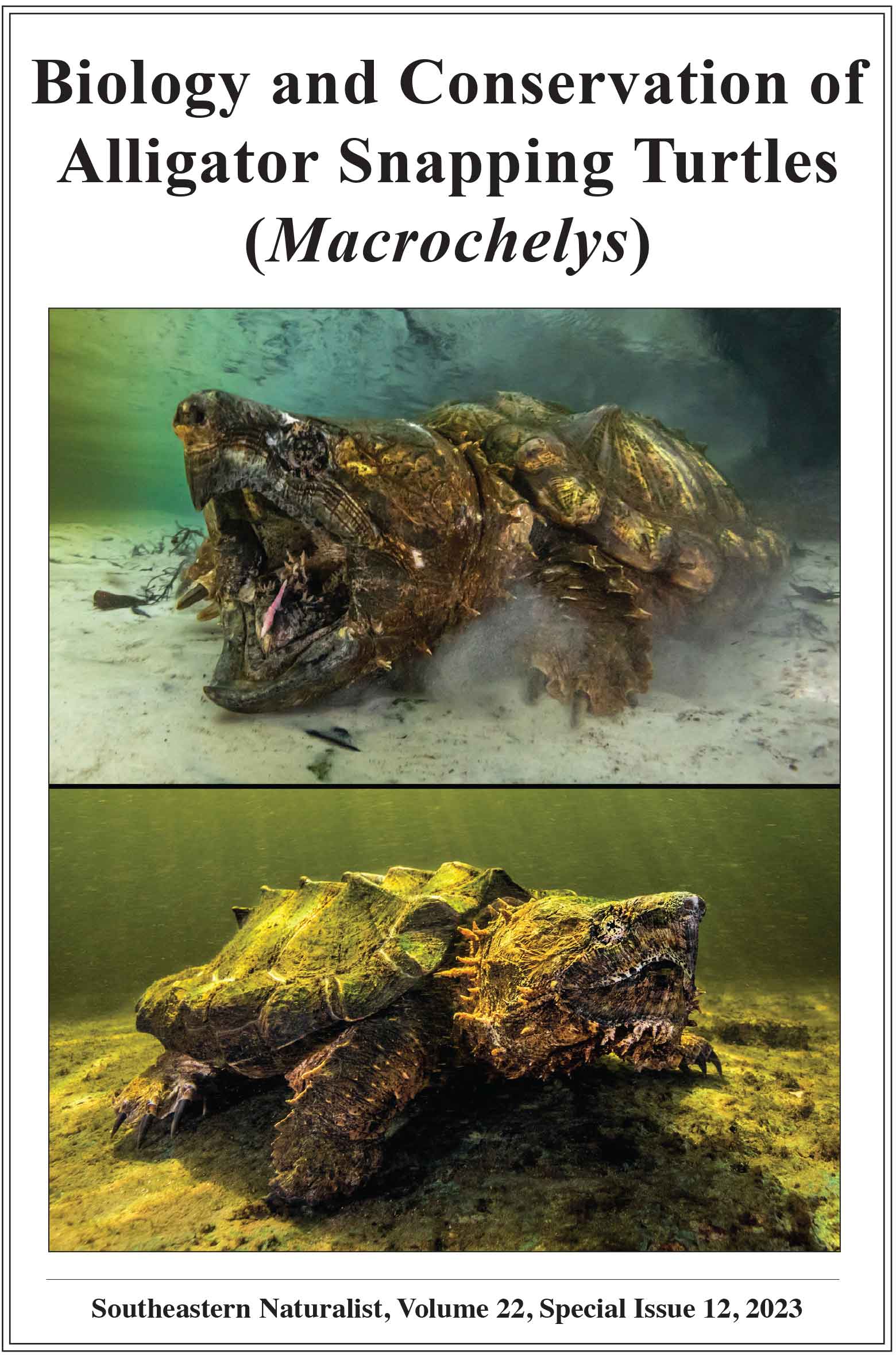Prevalence of a Potentially Lethal Parasite of Wading
Birds in Natural and Agricultural Wetlands in
South Louisiana
Margaret C. Luent, Melissa Collins, Clinton Jeske, and Paul Leberg
Southeastern Naturalist, Volume 11, Issue 3 (2012): 415–422
Full-text pdf (Accessible only to subscribers.To subscribe click here.)

2012 SOUTHEASTERN NATURALIST 11(3):415–422
Prevalence of a Potentially Lethal Parasite of Wading
Birds in Natural and Agricultural Wetlands in
South Louisiana
Margaret C. Luent1,2,*, Melissa Collins3,4, Clinton Jeske5, and Paul Leberg1
Abstract - Gambusia affinis (Western Mosquitofish) were sampled from 18 sites representing
marsh, forested wetlands, and agricultural wetlands in south Louisiana to
determine distribution and infection parameters of Eustrongylides ignotus, a potentially
lethal nematode parasite of wading birds. (n = 400 per site). Overall, prevalence of
infection was 0.3%, with significantly higher prevalence in agricultural wetlands than
in marshes or swamps. Our findings are similar to work in Florida suggesting parasite
prevalence is higher in disturbed wetlands, and suggest that birds foraging in crayfish
ponds and rice fields may be at increased risk of exposure.
Introduction
Epizootics in fish-eating birds (family Ardeidae) from many parts of the
United States have been attributed to the nematode Eustrongylides ignotus
Jäegerskiold (Franson and Custer 1994, Roffe 1988, Weise et al. 1977). During
outbreaks, affected colonies can lose high proportions of their nestlings (Roffe
1988, Spalding et al. 1993). The nematode has a three-host life cycle; fish become
infected via consumption of oligochaetes having consumed E. ignotus eggs released
with wading bird feces.
In Florida, one of the fish with the highest prevalence of infection is Gambusia
holbrooki Girard (Eastern Mosquitofish) (Coyner et al. 2002, Spalding et al.
1993). The prevalence of E. ignotus has not been assessed in Gambusia affinis
(Baird and Girard) (Western Mosquitofish), a close relative, although infections
are known to occur (Deaton 2009).
The Western Mosquitofish is probably the most common freshwater fish in
Louisiana and thus a good candidate for studying the potential distribution of
the parasite in various habitats used by foraging wading birds. Mosquitofish inhabit
shallow wetlands and shorelines, making them susceptible to bird predation
(Coyner et al. 2001). Even for species of herons that eat larger prey, the Mosquitofi
sh is useful for detecting the presence of E. ignotus in the environment.
Mosquitofish are more easily sampled in large numbers than larger fish (Coyner
1University of Louisiana at Lafayette, Department of Biology, PO Box 42451, Lafayette,
LA 70504. 2Current address - Louisiana Department of Wildlife and Fisheries,
102 Magnate Drive, Suite 201, Lafayette, LA 70508. 3IAP World Services, Inc., US
Geological Survey, National Wetlands Research Center, Lafayette, LA 70506. 4Current
address - 1056 Sandy Nell Road, Breaux Bridge, LA 70517. 5US Geological Survey,
National Wetlands Research Center, Lafayette, LA, 70506. *Corresponding author -
mluent@wlf.la.gov.
416 Southeastern Naturalist Vol. 11, No. 3
et al. 2002, Frederick et al. 1996). Additionally, larger piscivoruous fish may
accumulate E. ignotus by consuming infected mosquitofish; predators of those
larger fish might be more at risk of infection than smaller wading birds (Coyner
et al. 2003).
Prevalence of E. ignotus in Florida is highest in habitats impacted by disturbed
soils, altered hydrology, and exogenous nutrients (Coyner et al. 2002,
Spalding et al. 1993). Frederick et al. (1996) hypothesized recent increases in
the distribution and prevalence of the nematode may be in response to increased
human disturbance of aquatic systems.
Wading bird populations increased in Louisiana between 1949–1988, during
the same time period that there was an increase in crayfish aquaculture
(Fleury and Sherry 1995). If wading birds are food-limited, then crayfish/rice
impoundments may contribute to the abundance of wading birds in Louisiana by
increasing foraging-site availability (Fleury and Sherry 1995). However, if agricultural
impoundments support a large number of infected fish relative to what is
observed in natural wetlands, they may serve as an ecological sink diminishing
the reproductive success of foraging birds.
Due to the importance of Louisiana to continental populations of wading birds
(Martin and Lester 1990), we undertook a study to determine the prevalence and
intensity of infection of E. ignotus in Louisiana populations of mosquitofish. We
tested the null hypothesis that Western Mosquitofish from agricultural wetlands
do not have a higher occurrence of E. ignotus than do natural wetlands. We also
evaluated the association between parasite prevalence and fish abundance and
water quality.
Methods
We sampled fish from 6 sites representing each of three types of wetlands
(Fig. 1). All sampling sites were separated by at least 2 km. Forested sampling
sites included the Sherburne Wildlife Management Area (WMA), Lake Fausse
Point State Park (SP), Chicot SP, Thistlewaite WMA, Tunica Hills WMA, and
Maurepas WMA. Marsh sites included Mandalay National Wildlife Refuge
(NWR), Laccasine NWR, Sabine NWR, Cameron Prairie NWR, and Rockefeller
State Refuge. Agricultural wetland sites were temporarily flooded impoundments
used for both rice and crayfish production (sites located near Cade, Catahoula,
and Crowley) and ditches that drained such impoundments (sites located near
Kaplan, Maurice, and Ridge).
We sampled Gambusia when fledgling concentrations were highest (June–
July 2004). To estimate relative abundance of mosquitofish, we used a catchper-
unit-effort index. We sampled three areas of similar and suitable habitat
(less than 0.5 m deep, partially vegetated) at each site, vigorously sweeping a longhandled
dip net for three 3-minute catch intervals. Counts of fish collected
were averaged together to obtain a mean relative abundance for a site. This
index of abundance was uniform both in terms of number of subsamples and
the intensity of the sampling.
2012 M.C. Luent, M. Collins, C. Jeske, and P. Leberg 417
Our objective was to examine 400 fish per site for infection by E. ignotus.
If fewer fish were caught, we supplemented those numbers with additional
dip-netting in similar habitat. Fish were examined using a dissecting microscope,
individual infection status was noted, and nematodes were sent to M.
Kinsella, Department of Pathobiology at the University of Florida, for positive
identification.
Following Coyner et al. (2002), we determined total nitrogen, total phosphorous,
dissolved oxygen, and chlorophyll between 6–11 AM at each site in habitat
similar to that sampled for fish abundance. Dissolved oxygen was immediately
measured in the field using a galvanic sensor (YSI, Inc). Samples for total nitrogen,
total phosphorous, and chlorophyll were initially frozen prior to analysis at
the National Wetland Research Center in Lafayette, LA, using a CE440 Elemental
Analyzer (Leeman Labs, Inc.) or a 10-AU Fluorometer (Turner Designs). All results
are reported as mg/L.
Figure 1. Locations of six sample sites for each wetland type used to assess parasite
prevalence. The number of infected fish found in a sample (n = 400/site) is located next
to each site.
418 Southeastern Naturalist Vol. 11, No. 3
We used a nonparametric Kruskal-Wallis (KW) test to evaluate whether E. ignotus
prevalence and abundance differed among wetland types. If a KW test was
significant, we conducted a Dunn’s multiple comparison to assess differences
among wetland types. The same approach was used to assess differences of fish
abundance and water quality measures among wetland types. We tested the null
hypothesis of no correlation between parasite prevalence and measures of water
quality or fish abundance at our 18 sample sites using Pearson’s r. Finally we used
Poisson regression to determine if a combination of habitat with the water quality
variables or fish abundance better explained the variation in parasite prevalence
than did habitat alone.
Results and Discussion
Of the 7200 fish examined, 25 were infected by nematodes; all were confirmed
to be E. ignotus. We did not note the presence of any other parasites,
but did not conduct a microscopic evaluation. No fish was infected with more
than one E. ignotus. Therefore the prevalence per site provided the same
information as parasite abundance per site, so only the former is analyzed.
Overall prevalence of E. ignotus in southern Louisiana (0.3%) was slightly
lower than levels found in two large surveys in Florida (1.1% in Frederick et
al. 1996, and 0.6% in Coyner et al. 2002). However, infected mosquitofish
were found at 50% of our sampled sites, which was much higher than the occurrence
in Florida (14.7% and 17.1% of sites examined by Frederick et al.
1996 and Coyner et al. 2002, respectively). This difference in the proportion
of sites with infected fish between studies is probably not due to differences
in sampling intensity. While Frederick et al. (1996) examined fewer fish than
we did per site, Coyner et al. (2002) looked at an average of 360 fish per site
(which is similar to our sample of 400).
The prevalence of infected fish was higher in agricultural wetlands (0.9%)
than in forested wetlands or marshes (H = 10.44, P = 0.005; Fig. 2); there was
no difference between the two natural wetlands. The parasite was detected in all
of the agricultural wetland sites compared to only 1–2 sites within each of the
natural wetland types (Fig. 1). In Florida, infection prevalence is higher in altered
than in natural wetlands (Coyner et al. 2002, Frederick et al. 1996, Spalding et
al. 1993). The man-made habitats in Florida associated with increased parasite
prevalence and occurrence, however, were not agricultural wetlands. The reason
for increased prevalence of parasitized fish in artificial wetlands is unclear,
but it could be due to higher use of agricultural wetlands by wading birds, or to
higher oligochaete populations, than in natural wetlands, either of which would
enhance the ability of the parasite to complete its life cycle. Unfortunately, to
our knowledge, relative habitat use by wading birds or relative abundance in of
oligochaetes in natural and agricultural wetlands has not been assessed.
No correlation was found between dissolved oxygen, phosphorus, chlorophyll,
or fish abundance and nematode prevalence (Table 1); nitrogen
2012 M.C. Luent, M. Collins, C. Jeske, and P. Leberg 419
was below the detection limits across the sites. Furthermore, water quality
measures and fish abundance did not differ among wetland types (Table 1).
Coyner et al. (2002) observed the higher levels of total nitrogen, total
Figure 2. Box plot (25 and
75 quartiles) indicating differences
in parasite prevalence
among wetland types.
The median and mean
prevalence for 6 sample
sites are indicated by dark
horizontal solid and dashed
lines, respectively (the median
corresponded with the
25th quartile for two wetland
types). The vertical
bars represent the range of
prevalence for each wetland
type. Letters above bars are
based on the results of a
Dunn’s multiple comparison
test; prevalence did not
differ among wetland types
identified with the same
letter.
Table 1. Water quality measurements1 and fish abundance for three wetland types and Spearman’s
correlation (R) coefficient between these measurements and nematode abundance (n = 12). The
null hypothesis that the environmental variable did not differ among habitats was evaluated with
a Kruskal Wallis (H) test.
Environmentalvariable Wetland types Mean SD R P H P
Dissolved oxygen (mg/L)
Forested 5.59 1.80
Marsh 7.34 3.25
Agricultural 8.52 4.54 0.30 0.22 1.37 0.53
Chlorophyll (mg/L) 0.50 0.80
Forested 32.50 26.38
Marsh 36.50 35.65
Agricultural 58.57 54.98 0.13 0.62 1.14 0.58
Phosphorous (mg/L)
Forested 0.12 0.09
Marsh 0.14 0.08
Agricultural 0.25 0.21 0.35 0.15 1.14 0.58
Fish relative abundance (mean number captured in three 3-mimute samples)
Forested 87.57 67.15
Marsh 149.17 274.56
Agricultural 46.58 27.01 -0.155 0.53 1.22 0.56
1Nitrogen was also measured but was below detection limits at most sites and so is not presented.
420 Southeastern Naturalist Vol. 11, No. 3
phosphorous, and chlorophyll and lower levels of dissolved oxygen at altered
wetland sites compared to natural wetlands in Florida were associated with
E. ignotus prevalence. We found no similar correlations or significant differences
in water quality among wetland types; however, subtle differences
in water quality among wetland types might not have been detected with our
sample size of only 18 sites.
Poisson regressions to assess the effects of combinations of variables on prevalence
lacked sufficient samples to model interactions between environmental
variables, including fish abundance, with habitat (based on model convergence
statistics). When assessing main effects on parasite prevalence, none of the environmental
variables significantly improved on the explanatory power of the
model containing only wetland type (χ2
2 =18.58, P = 0.001) except for the model
containing both wetland type and DO (χ2
3 = 21.44, P = 0.001). The odds of detecting
an additional parasite in a sample increased 1.165 (95% CI = 1.064–1.28)
times for each mg increase of dissolved oxygen per liter at a site, when controlling
for the effects of wetland type. For comparison, the odds of finding an additional
parasite per 400 fish in a sample from agricultural wetlands were 7.79 (95% CI =
1.79–49.40) and 10.50 (95% CI = 2.46–44.79) times higher than in either marsh
or forested wetlands, respectively. We found that parasite prevalence was positively
associated with DO within wetland types, and was highest in agricultural
wetlands, which did not appear to be eutrophic relative to natural wetlands. This
finding is different than in Florida where high parasite prevalence was associated
with low DO levels found in eutrophic artificial wetlands (Coyner et al. 2002).
This difference suggests that the mechanism responsible for increased parasite
prevalence in artificial wetlands in Louisiana differs from the one proposed by
Coyner et al. (2002) in Florida.
We found E. ignotus infects the Western Mosquitofish in Louisiana at similar
levels as have been observed in Eastern Mosquitofish in Florida. Outbreaks
of E. ignotus associated with high hatchling mortality have been documented
in Louisiana and Texas (Franson and Custer 1994, Roffe 1988). Assuming the
biology of parasite and hosts is similar to that found in Florida, bird infections
in Louisiana may be derived from direct consumption of infected Mosquitofish
or from the consumption of larger fish infected by eating Mosquitofish
harboring E ignotus.
Louisiana leads the US in crayfish aquaculture (McClain and Romaire
2007). Large, shallow ponds with high densities of crustaceans are major foraging
sites for wading birds (Fleury and Sherry 1995). Although these ponds
provide foraging sites for wading birds, they also harbor parasitic nematodes
that are potentially lethal to juvenile wading birds. If parasitic nematodes are
present in agricultural wetlands then they could lead to a reduction in wading
bird reproductive success. As a precaution, we suggest agricultural wetlands be
monitored to assess presence and abundance of parasitic nematodes. Such efforts
would benefit from verification that the observed prevalence of parasites
is high enough to cause a threat to wading birds (although Spalding and
2012 M.C. Luent, M. Collins, C. Jeske, and P. Leberg 421
Forrester 1991 show that ingestion of 4 larvae can be lethal to juveniles) and
that Gambusia is the best choice for a sentinel species. If a particular pond was
found to have unusually high densities of infected fish, a rapid drawdown or an
increase in water depth might be used to reduce the access of birds to fish
(Coyner et al. 2002). Investigations into impoundment designs or management
to reduce bird use might also be warranted.
Acknowledgments
We thank M. Kinsella for identification of nematodes, A. Hitch and J. Larrivere for help
with field collections, and T. Doyle, K. Krauss, and T. Michot for editorial comments.
Literature Cited
Coyner, D.F., S.R. Schaack, M.G. Spalding, and D.J. Forrester. 2001. Altered predation
susceptibility of mosquitofish infected by Eustrongylides ignotus. Journal of Wildlife
Diseases 37:556–560.
Coyner, D.F., M.G. Spalding, and D.J. Forrester. 2002. Epizootiology of Eustrongylides
ignotus in Florida: Distribution, density, and natural infections in intermediate hosts.
Journal of Wildlife Diseases 39:483–499.
Coyner, D.F., M.G. Spalding, and D.J. Forrester. 2003. Epizootiology of Eustrongylides
ignotus in Florida: Transmission and development of larvae in intermediate hosts.
Journal of Parasitology 89:290–298.
Deaton, R. 2009. Effects of a parasitic nematode on male mate choice in a live-bearing
fish with a coercive mating system (Western Mosquitofish, Gambusia affinis). Behavioral
Processes 80:1–6.
Fleury, B.E., and T.W. Sherry. 1995. Long-term population trends of colonial wading
birds in the southern United States: The impact of crayfish aquaculture on Louisiana
populations. The Auk 112:613–632.
Franson, J.C. and T.W. Custer. 1994. Prevalence of Eustrongylidosis in wading birds
from colonies in California, Texas, and Rhode Island, USA. Colonial Waterbirds
17:168–172
Frederick, P.C., S.M. McGehee, and M.G. Spalding 1996. Prevalence of Eustrongylides
ignotus in Mosquitofish (Gambusia holbrooki) in Florida: Historical and regional
comparisons. Journal of Wildlife Diseases 32:552–555.
Martin, R.P., and G.D. Lester. 1990. Atlas and census of wading bird and seabird nesting
colonies in Louisiana: 1990. Louisiana Department of Wildlife and Fisheries and
Louisiana Natural Heritage Program Special Publication No. 3. Baton Rouge, LA.
182 pp.
McClain, W.R., and R.P. Romaire. 2007. Procambarid crawfish life history and biology.
Southern Regional Aquaculture Center, Stoneville, MS. Publication No. 2403. EUA.
6 pp.
Roffe, T.J. 1988. Eustrongylides sp. epizootic in young Common Egrets (Casmerodius
albus). Avian Diseases 32:143–147.
Spalding, M.G., and D.J. Forrester. 1991. Effects of parasitism and disease on the nesting
success of colonial wading birds (Ciconiiformes) in southern Florida. Florida Game
and Fresh Water Fish Commission Final Report, Tallahassee, FL. 130 pp.
422 Southeastern Naturalist Vol. 11, No. 3
Spalding, M.G., G.T. Bancroft, and D.J. Forrester. 1993. The epizootiology of eustrongylidosis
in wading birds (Ciconiiformes) in Florida. Journal of Wildlife Diseases
29:237–249.
Weise, J.H., W.R. Davidson, and V.F. Nettles. 1977. Large-scale mortality of nestling
ardeids caused by nematode infection. Journal of Wildlife Diseases 13:376–382.













 The Southeastern Naturalist is a peer-reviewed journal that covers all aspects of natural history within the southeastern United States. We welcome research articles, summary review papers, and observational notes.
The Southeastern Naturalist is a peer-reviewed journal that covers all aspects of natural history within the southeastern United States. We welcome research articles, summary review papers, and observational notes.